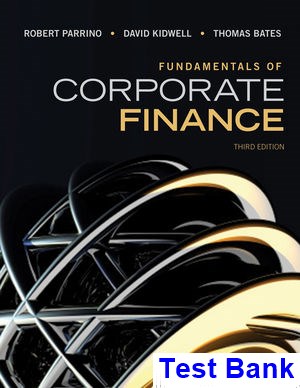This is completed downloadable of Fundamentals of Corporate Finance 3rd Edition Parrino Test Bank

Product Details:
- ISBN-10 : 0730363465
- ISBN-13 : 978-0730363460
- Author:
Fundamentals of Corporate Finance, 3rd Edition presents finance in a cutting-edge interactive digital format designed to motivate students by taking the road blocks out of self-study and to facilitate mastery through drill-and-skill practice.
Available as a full colour printed textbook with an interactive eBook code, this title enables every student to master concepts and succeed in assessment. Lecturers are supported with an extensive, easy-to-use teaching and learning package.
Table of Content:
- Part 1 Introduction
- Chapter 1 The financial manager and the company
- Chapter preview
- 1.1 The role of the financial manager
- Stakeholders
- It’s all about cash flows
- Three fundamental decisions in financial management
- 1.2 Forms of business organisation
- Sole traders
- Partnerships
- Companies
- 1.3 Managing the financial function
- Organisation structure
- Positions reporting to the CFO
- External auditors
- The audit committee
- 1.4 The goal of the company
- What should management maximise?
- Why not maximise profits?
- Maximise the value of the company’s shares
- Can management decisions affect share prices?
- 1.5 Agency conflicts: separation of ownership and control
- Ownership and control
- Agency relationships
- Do managers really want to maximise share price?
- Aligning the interests of management and shareholders
- 1.6 The importance of ethics in business
- Business ethics
- Are business ethics different from everyday ethics?
- Types of ethical conflicts in business
- The importance of an ethical business culture
- Serious consequences
- Concept check
- Summary
- Key terms
- Self-study problems
- Critical thinking questions
- Questions and problems
- Endnotes
- Acknowledgements
- Chapter 2 The financial environment and the level of interest rates
- Chapter preview
- 2.1 The financial system
- The financial system at work
- How funds flow through the financial system
- 2.2 Direct financing
- A direct financing transaction (without using the market)
- Direct financing (using the market)
- 2.3 Types of financial markets
- Primary and secondary markets
- Exchanges and over-the-counter markets
- Money and capital markets
- Public and private markets
- Futures and options markets
- 2.4 Financial institutions and indirect financing
- Indirect market transactions
- Financial institutions and their services
- Companies and the financial system
- 2.5 The determinants of interest rate levels
- The real rate of interest
- Loan contracts and inflation
- The Fisher equation and inflation
- Cyclical and long-term trends in interest rates
- Planning ahead by financial managers
- Concept check
- Summary
- Key terms
- Summary of key equations
- Self-study problems
- Critical thinking questions
- Questions and problems
- Endnotes
- Acknowledgements
- Part 2 Valuation of future cash flows and risk
- Chapter 3 The time value of money
- Chapter preview
- 3.1 The time value of money
- Consuming today or tomorrow?
- Time lines as aids to problem solving
- The financial calculator
- 3.2 Future value and compounding
- Single-period investment
- Two-period investment
- The future value equation
- The future value factor
- Applying the future value formula
- Calculator tips for future value problems
- 3.3 Present value and discounting
- Single-period investment
- Multiple-period investment
- The present value equation
- Future and present value equations are the same
- Applying the present value formula
- The relationship between time, the discount rate and present value
- Calculator tips for present value problems
- Future value versus present value
- 3.4 Additional concepts and applications
- Finding the interest rate
- Finding how many periods it takes an investment to grow to a certain amount
- Compound growth rates
- Concluding comments
- Concept check
- Summary
- Key terms
- Summary of key equations
- Self-study problems
- Critical thinking questions
- Questions and problems
- Endnotes
- Acknowledgements
- Chapter 4 Discounted cash flows and valuation
- Chapter preview
- 4.1 Multiple cash flows
- Future value of multiple cash flows
- Present value of multiple cash flows
- 4.2 Level cash flows: annuities and perpetuities
- Present value of an annuity
- Future value of an annuity
- 4.3 Perpetuities
- Annuities due
- 4.4 The effective annual interest rate
- Why the confusion?
- Calculating the effective annual interest rate
- Comparing interest rates
- Consumer protection acts and interest rate disclosure
- The appropriate interest rate factor
- Concept check
- Summary
- Key terms
- Summary of key equations
- Self-study problems
- Critical thinking questions
- Questions and problems
- Appendix: Deriving the formula for the present value of an ordinary annuity
- Endnotes
- Acknowledgements
- Chapter 5 Risk and return
- Chapter preview
- 5.1 Risk and return
- 5.2 Quantitative measures of return
- Holding period returns
- 5.3 Expected returns
- 5.4 The variance and standard deviation as measures of risk
- Calculating the variance and standard deviation
- Interpreting the variance and standard deviation
- Historical market performance
- 5.5 Risk and diversification
- Single-asset portfolios
- Portfolios with more than one asset
- The limits of diversification
- 5.6 Systematic risk
- Why systematic risk is all that matters
- Measuring systematic risk
- Compensation for bearing systematic risk
- 5.7 The Capital Asset Pricing Model
- The Security Market Line
- The Capital Asset Pricing Model and portfolio returns
- A word of caution for the CAPM
- Concept check
- Summary
- Key terms
- Summary of key equations
- Self-study problems
- Critical thinking questions
- Questions and problems
- Endnotes
- Acknowledgements
- Chapter 6 Bond valuation and the structure of interest rates
- Chapter preview
- 6.1 Capital market efficiency
- Efficient market hypotheses
- 6.2 Corporate bonds
- Market for corporate bonds
- Bond price information
- Types of corporate bonds
- 6.3 Bond valuation
- The bond valuation formula
- Calculator tip: bond valuation problems
- Par, premium and discount bonds
- Semiannual compounding
- Zero coupon bonds
- 6.4 Bond yields
- Yield to maturity
- Effective annual yield
- Realised yield
- 6.5 Interest rate risk
- Bond theorems
- Bond theorem applications
- 6.6 The structure of interest rates
- Marketability
- Call provision
- Default risk
- 6.7 The term structure of interest rates
- Concept check
- Summary
- Key terms
- Summary of key equations
- Self-study problems
- Critical thinking questions
- Questions and problems
- Endnotes
- Acknowledgements
- Chapter 7 Share valuation
- Chapter preview
- 7.1 The market for shares
- Secondary markets
- Secondary markets and their efficiency
- Reading the share market listings
- 7.2 Ordinary and preference shares
- Preference shares: debt or equity?
- Ordinary share valuation
- A one-period model
- A perpetuity model
- 7.3 The general dividend valuation model
- The growth share pricing paradox
- 7.4 Share valuation: some simplifying assumptions
- Zero growth dividend model
- Constant growth dividend model
- Calculating future share prices
- The relationship between R and g
- Mixed (supernormal) growth dividend model
- 7.5 Valuing preference shares
- Preference shares with a fixed maturity
- Perpetuity preference shares
- Concept check
- Summary
- Key terms
- Summary of key equations
- Self-study problems
- Critical thinking questions
- Questions and problems
- Endnotes
- Acknowledgements
- Part 3 Capital budgeting decisions
- Chapter 8 The fundamentals of capital budgeting
- Chapter preview
- 8.1 An introduction to capital budgeting
- The importance of capital budgeting
- The capital budgeting process
- Sources of information
- Classification of investment projects
- Basic capital budgeting terms
- 8.2 Net present value
- Valuation of real assets
- NPV — the basic concept
- NPV and value creation
- Framework for calculating NPV
- Net present value technique
- Concluding comments on NPV
- 8.3 The payback period
- Calculating the payback period
- How the payback period performs
- Discounted payback period
- Evaluating the payback rule
- 8.4 The accounting rate of return
- 8.5 Internal rate of return
- Calculating the IRR
- When the IRR and NPV methods agree — independent projects and conventional cash flows
- When the IRR and NPV methods disagree — mutually exclusive projects and unconventional cash flows
- Modified internal rate of return (MIRR)
- IRR versus NPV: a final comment
- 8.6 Capital budgeting in practice
- Practitioners’ methods of choice
- Ongoing and postaudit reviews
- Concept check
- Summary
- Key terms
- Summary of key equations
- Self-study problems
- Critical thinking questions
- Questions and problems
- Appendix: An example using a financial calculator for capital budgeting calculations
- Endnotes
- Acknowledgements
- Chapter 9 Cash flows and capital budgeting
- Chapter preview
- 9.1 Calculating project cash flows
- Cash flow versus accounting earnings
- Incremental after-tax free cash flows
- The FCF calculation
- Cash flows from operations
- Cash flows associated with investments
- The FCF calculation: an example
- 9.2 Estimating cash flows in practice
- Five general rules for incremental after-tax free cash flow calculations
- Nominal versus real cash flows
- Tax rates and depreciation
- Calculating the terminal-year FCF
- Expected cash flows
- 9.3 Projects with different lives
- 9.4 When to harvest an asset
- When to replace an existing asset
- The cost of using an existing asset
- Concept check
- Summary
- Key terms
- Summary of key equations
- Self-study problems
- Critical thinking questions
- Questions and problems
- Endnotes
- Acknowledgements
- Chapter 10 Evaluating project economics and capital rationing
- Chapter preview
- 10.1 Variable costs, fixed costs and project risk
- Cost structure and sensitivity of EBITDA to revenue changes
- Cost structure and sensitivity of EBIT to revenue changes
- 10.2 Calculating operating leverage
- Degree of pre-tax cash flow operating leverage
- Degree of accounting operating leverage
- 10.3 Break-even analysis
- Pre-tax operating cash flow break-even
- Accounting break-even
- 10.4 Risk analysis
- Sensitivity analysis
- Scenario analysis
- Simulation analysis
- Decision tree analysis
- 10.5 Investment decisions with capital rationing
- Capital rationing in a single period
- Capital rationing across multiple periods
- Concept check
- Summary
- Key terms
- Summary of key equations
- Self-study problems
- Critical thinking questions
- Questions and problems
- Endnotes
- Acknowledgements
- Chapter 11 The cost of capital
- Chapter preview
- 11.1 The company’s overall cost of capital
- The finance balance sheet
- How companies estimate their cost of capital
- 11.2 The cost of debt
- Key concepts for estimating the cost of debt
- Estimating the current cost of a bond or an outstanding loan
- Tax and the cost of debt
- Estimating the cost of debt for a company
- 11.3 The cost of equity
- Ordinary shares
- Preference shares
- 11.4 Using the WACC in practice
- Calculating WACC: an example
- Limitations of WACC as a discount rate for evaluating projects
- Alternatives to using WACC for evaluating projects
- Consistency of the WACC and Dividend Discount Models
- Concept check
- Summary
- Key terms
- Summary of key equations
- Self-study problems
- Critical thinking questions
- Questions and problems
- Sample test problems
- Endnotes
- Acknowledgements
- Part 4 Working capital management and financing decisions
- Chapter 12 Working capital management
- Chapter preview
- 12.1 Working capital basics
- Working capital terms and concepts
- Working capital accounts and trade-offs
- 12.2 The operating and cash conversion cycles
- Operating cycle
- Cash conversion cycle
- 12.3 Working capital management strategies
- Flexible current asset management strategy
- Restrictive current asset management strategy
- The working capital trade-off
- 12.4 Accounts receivable
- Terms of sale
- Ageing accounts receivable
- 12.5 Inventory management
- Economic order quantity
- Just-in-time inventory management
- 12.6 Cash management and budgeting
- Reasons for holding cash
- Cash collection
- 12.7 Financing working capital
- Strategies for financing working capital
- Financing working capital in practice
- Sources of short-term financing
- Concept check
- Summary
- Key terms
- Summary of key equations
- Self-study problems
- Critical thinking questions
- Questions and problems
- Endnotes
- Acknowledgements
- Chapter 13 How companies raise capital
- Chapter preview
- 13.1 Bootstrapping
- How new businesses get started
- Initial funding of the company
- 13.2 Venture capital
- The venture capital industry
- Why venture capital funding is different
- The venture capital funding cycle
- The cost of venture capital funding
- 13.3 Initial public offering
- Advantages and disadvantages of going public
- Investment banking services
- Origination
- Underwriting
- The proceeds
- 13.4 IPO pricing and cost
- The underpricing debate
- IPOs are consistently underpriced
- The cost of an IPO
- 13.5 Open offers by a public company
- The cost of an open public offer
- 13.6 Private markets and bank loans
- Private versus public markets
- Private placements
- Private equity companies
- 13.7 Commercial bank lending
- Business overdraft
- Bank term loans
- The loan pricing model
- Concluding comments on funding the company
- Concept check
- Summary
- Key terms
- Summary of key equation
- Self-study problems
- Critical thinking questions
- Questions and problems
- Endnotes
- Acknowledgements
- Chapter 14 Capital structure policy
- Chapter preview
- 14.1 Capital structure and company value
- The optimal capital structure
- The Modigliani and Miller propositions
- 14.2 The benefits and costs of using debt
- The benefits of debt
- The costs of debt
- 14.3 Two theories of capital structure
- The trade-off theory
- The pecking order theory
- The empirical evidence
- 14.4 Practical considerations in choosing a capital structure
- Concept check
- Summary
- Key terms
- Summary of key equations
- Self-study problems
- Critical thinking questions
- Questions and problems
- Endnotes
- Acknowledgements
- Chapter 15 Dividends and dividend policy
- Chapter preview
- 15.1 Dividends
- Types of dividends
- Dividends and taxation
- The dividend payment process
- 15.2 Share buy-backs
- How share buy-backs differ from dividends
- How a share buy-back happens
- 15.3 Dividend policy and company value
- Benefits and costs of dividends
- Share price reactions to dividend announcements
- Dividends versus share buy-backs
- 15.4 Bonus share issues and share splits
- Bonus share issues
- Share splits
- Reasons for bonus share issues and splits
- 15.5 Setting a dividend policy
- What managers tell us
- Practical considerations in setting a dividend policy
- Concept check
- Summary
- Key terms
- Self-study problems
- Critical thinking questions
- Questions and problems
- Endnotes
- Acknowledgements
- Part 5 Business formation, valuation and financial planning
- Chapter 16 Business formation, growth and valuation
- Chapter preview
- 16.1 Starting a business
- Making the decision to proceed
- Choosing the right organisational form
- Financial considerations
- 16.2 The role of the business plan
- Why business plans are important
- The key elements of a business plan
- 16.3 Valuing a business
- Fundamental business valuation principles
- Business valuation approaches
- 16.4 Important issues in valuation
- Public versus private companies
- Young (rapidly growing) versus mature companies
- Controlling interest versus non-controlling interest
- Key people
- Concept check
- Summary
- Key terms
- Summary of key equations
- Self-study problems
- Critical thinking questions
- Questions and problems
- Endnotes
- Acknowledgements
- Chapter 17 Strategic financial planning and forecasting
- Chapter preview
- 17.1 Financial planning
- The planning documents
- Concluding comments
- 17.2 Financial planning models
- The sales forecast
- Building a financial planning model
- A simple planning model
- 17.3 A better financial planning model
- Blackwell Sales Ltd
- The income statement
- The balance sheet
- The preliminary pro forma balance sheet
- The final pro forma balance sheet
- 17.4 Beyond the basic planning models
- Improving financial planning models
- 17.5 Managing and financing growth
- External funding needed
- A graphical view of growth
- The internal growth rate
- The sustainable growth rate
- Growth rates and profits
- Growth as a planning goal
- Concept check
- Summary
- Key terms
- Summary of key equations
- Self-study problems
- Critical thinking questions
- Questions and problems
- Endnotes
- Acknowledgements
- Part 6 Options and corporate finance and international decisions
- Chapter 18 Options and corporate finance
- Chapter preview
- 18.1 Financial options
- Call options
- Put options
- American, European and Bermudan options
- More on the shapes of option pay-off functions
- 18.2 Option valuation
- Limits on option values
- Variables that affect option values
- The binomial option pricing model
- Put-call parity
- Valuing options associated with financial securities issued by companies
- 18.3 Real options
- Options to defer investment
- Options to make follow-on investments
- Options to change operations
- Options to abandon projects
- 18.4 Agency costs
- Agency costs of debt
- Agency costs of equity
- 18.5 Options and risk management
- Concept check
- Summary
- Key terms
- Summary of key equations
- Self-study problems
- Critical thinking questions
- Questions and problems
- Endnotes
- Acknowledgements
- Chapter 19 International financial management
- Chapter preview
- 19.1 Introduction to international financial management
- Globalisation of the world economy
- The rise of multinational companies
- Factors affecting international financial management
- Goals of international financial management
- Basic principles remain the same
- 19.2 Foreign exchange markets
- Market structure and major participants
- Foreign exchange rates
- The equilibrium exchange rate
- Foreign currency quotations
- 19.3 International capital budgeting
- Determining cash flows
- Exchange rate risk
- Country risk
- The Barcelona example
- 19.4 Global money and capital markets
- The emergence of the Euromarkets
- The Eurocurrency market
- The Eurocredit market
- International bond markets
- 19.5 International banking
- Risks involved in international bank lending
- Eurocredit bank loans
- Concept check
- Summary
- Key terms
- Summary of key equations
- Self-study problems
- Critical thinking questions
- Questions and problems
- Endnotes
- Acknowledgements
- Appendix A Present value and future value tables
- Appendix B Solutions to self-study problems
- Chapter 1
- Chapter 2
- Chapter 3
- Chapter 4
- Chapter 5
- Chapter 6
- Chapter 7
- Chapter 8
- Chapter 9
- Chapter 10
- Chapter 11
- Chapter 12
- Chapter 13
- Chapter 14
- Chapter 15
- Chapter 16
- Chapter 17
- Chapter 18
- Chapter 19
- EULA





